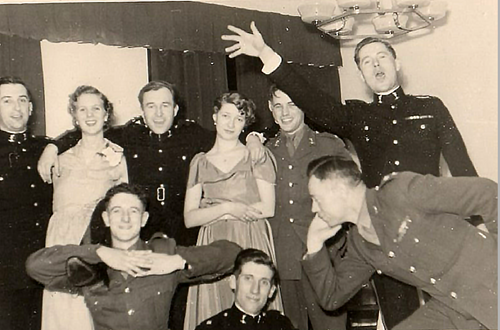Memoirs of Brigadier Ian Martin Rose
With our grateful thanks to Antony Rose.
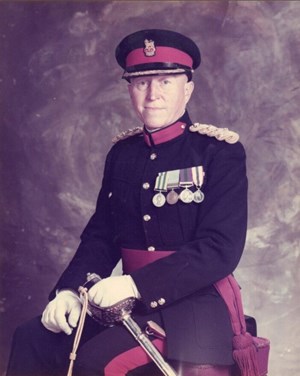
Just before Christmas 1946 a buff-coloured envelope, marked OHMS, arrived via the postman; inside was a railway warrant for an ominous one-way ticket to Bury St Edmunds and a formal letter to report for National Service on 16 January 1947. My call-up papers for the Army had arrived.
Due to be called up at 17 ½, I had requested deferment in order to take a BSc (Bachelor of Science) exam. I had taken the Higher School Certificate in pure maths, applied maths, physics and chemistry but my marks in applied maths were not high enough to give me an inter-BSc exemption. At school I could not get the hang of applied maths but perversely in later life, at Cambridge, found it fascinating and easy, perhaps a reflection on the teaching. So, I had to take the one paper again, necessitating appearing at an interview before a deferment board. One of the questions was ‘Was I trying to get out of going into the Army?’ Little did they or I know what the future had in store. I sat the exam in some vast examination hall in London, passed the paper, received my inter-BSc. and was called up or conscripted, as it was then known, for ‘Service with the Colours’.
At Bury St Edmunds in Suffolk about 30 young men were met on the platform by a couple of corporals and told to stand in threes outside the station. We were walked to the car park to board Army 3-ton lorries. A short drive and we entered the Suffolk Regiment Barracks. Ancient grim buildings, they must have been built during the Crimean War. We were given a quick meal and then ushered in threes, to the QM’s store. Here boots, tin hat, battledress, greatcoat, underwear, webbing, PT kit, etc. and blankets were issued.
Sheets were not issued. I did not have the luxury of those from the Army until I became a cadet. With greatcoats on and feeling like a packhorse, it was to the barrack room. A large, first-floor barn of a room holding about 30 men; the only heating being a small, round stove. The washing facilities and the lavatories were downstairs and outside, fully open to the elements with only cold water. The first task given to us by the corporal in the barrack room was to take off all our civilian clothes and put on the Army underwear and uniform. The corporal, who we now realised was ‘our’ corporal, showed us how to fit it. Next, the civilian clothes were parcelled up in brown paper, taken away and sent home by the Army. I was now a private in the General Service Corps at a Primary Training Centre (PTC). I was in the Army.
Looking like Dad’s Army, we were then taken to a store for the bed mattresses. Mattresses? We were given a large linen bag called a palliasse, and then taken to a hut to fill it with straw. Those in the know saying don’t fill it too much, it will be too hard. But not enough and it would still be hard!
I was at Bury St Edmunds until 26 February 1947. The period coincided with the start of the coldest winter that England had had for years. Snow was on the ground, the parade ground was an ice rink, the rifle ranges were impossible to use, outdoor training of any kind became difficult and in many cases impossible. The barrack room with its one tiny stove was like a refrigerator; wood was scrounged and even chairs were broken up to burn in the stove. We got it to be white-hot but it did not make much difference to the barn of a room. Going outside for the lavatories and washing was like a visit to the Arctic, relieved by the cookhouse providing buckets of hot water, the only taps (cold) had frozen. However, we all seemed remarkably cheerful accepting the conditions as a fact of life. It was here that I ‘earned’ my first money. At the end of the first week we had pay parade. Left right, left right, march up to the pay table draped in a Union Jack, salute, hand out to receive from the young subaltern a £1 note. I promptly dropped it – not an auspicious start. Out of that pound had to come cleaning kit, barrack damages and something unfathomable to us called stoppages; that left a small sum for tea and buns at the NAAFI for the rest of the week. But as buns were only 2d each and tea 4d (2p) it more than lasted.
The traditional end-of-course competition for the best platoon was decided not on the parade ground, due to the ice and snow, but on smartness of dress and barrack room inspections. For these, we would make up the beds and kit layout the night before and then sleep on the floor! I think we were petrified of the corporal rather than keen. The other soldiers in my barrack room were a complete cross-section of the community, from the higher educated to the illiterate; it was quite an eye opener. Some had odd habits, like Clayton the one who always smelt anything he touched, another couldn’t dress himself properly, giving us a problem for inspections and he had to be helped. Others recounted lurid tales to each other of their exploits with girls (that was an eye-opener). But somehow we all got on together, pulled together and formed a team; our corporal seemed pleased anyway.
The Royal Corps of Signals
On 26 February 1947 life at the PTC came to an end and after a 48-hour leave we all went our different ways into various Corps and Regiments. I noted that the least intelligent of the bunch went into the Army Catering Corps, or perhaps they just had a shortage at the time for it was not always borne out in my later career. I went into Royal Signals and reported to Catterick Camp. Why Royal Signals? I didn’t fancy the Infantry or tanks. I could have chosen the Royal Engineers, following my father who was a Sapper in the First World War or REME (Royal Electrical and Mechanical Engineers), but REME were a little below par in status. What swayed me into Signals was the fact that I had a girlfriend, Anne, whose father was a Colonel in Signals, serving at the time in Italy, and I thought joining Signals would impress her! Amusingly, about 18 months later whilst on leave from Sandhurst, I called at her house to go out for a walk (innocent pleasures in those days). Her father who I had never met, was home on leave and came down the stairs to meet me, dressed in uniform, perhaps to impress me? Whilst Anne was upstairs getting ready he talked to me about how the smell of various objects, especially metal, depended on their vapour density. He was probably probing my knowledge of science, but I was lost.
Arriving at Richmond station for Catterick, my first impression was of soldiers shovelling coal in Army 3-ton lorries. The severe winter had caused a coal distribution problem; the Army was short and so were the civilians in Richmond. After the barracks at Bury St Edmunds, Catterick was luxury (at first). I was sent to 3 Training Regiment in Bourlon Lines to train as an operator wireless and line (OWL). They were in one of the 1938-built Sandhurst blocks, about ten soldiers to a room, centrally heated, decent toilet facilities and a central dining room in the building. We still ate out of mess tins and after the meal we had to take them outside to the three large tanks of hot water marked ‘wash, rinse and sterilise’ (Ironically, my first posting after Sandhurst was back at Bourlon, but this time in the officers’ mess). Training as an OWL for some reason was not due to start for some time and I was employed on fatigues which varied from coal shovelling to peeling potatoes in the cook-house; life in the kitchens was again an eye-opener, especially where both male and female ACC cooks were employed. When the course was finally due to start it was decided that I should not be an OWL after all but should train as a Radio Mechanic. So it meant leaving the luxury of Bourlon and going up the hill in Catterick to 1 Training Regiment to live in what was called a spider, a WW1 single-storey block designed like an H with the toilet facilities in the horizontal bar. This was on Whinny Hill, aptly nicknamed ‘Windy Hill’; it was now April and the snow was still on the ground.
The barrack rooms consisted of triple bunks housing about 36 soldiers to a room. At the end was a little wooden room, the NCO’s bunk. I arrived fairly early and grabbed a top bunk; I did not fancy the middle or bottom one. The top meant a climb up but it seemed worth it. Although we had bunks, we did have the luxury of square mattresses called ‘biscuits’, we had three of them to a bed and like the Army biscuits they were hard. Training consisted mainly of classroom lectures by NCOs on electricity, physics, radio theory etc, not very trying, with the odd parade thrown in.
There was not much to do in the evenings. The many NAAFIs in Catterick had evening entertainment but seemed to attract all the dubious girls from Darlington and the standard was pretty low. So I joined the Catterick Theatre Club, having previously done some acting with a Bromley theatre club whilst on my deferment at home. The theatre club was started by General Carey in 1946 to provide some entertainment for the families and soldiers in Catterick. He converted a WW1 gymnasium into quite a presentable theatre that was duly called The Carey Theatre. Plays ran for three days and I had a number of bit parts in about four before appearing in my last play, The Duke In Darkness by Patrick Hamilton, as Count D’Aublaye, a rather pansy Elizabethan. I had one fairly long speech and halfway through it on the second night I lost my line. I couldn’t hear the prompt and I couldn’t just stand there, so I ad-libbed. I can still see the puzzled faces in the front two rows. (The third night was fine).
About this time I decided I would try for Sandhurst. In January 1947 it had just started up again after the war. There was a feeling in the country, fairly prevalent at that time, that there had only been 20 years between WW1 and WW2 and it looked as though another war was possible with a shorter respite and this time against Russia. It seemed to me that if it did come one would be called up into the Army anyway so if it was going to be inevitable why not make a career of it?
If I didn’t go into the Army my plan was to go to university to read mathematics, but beyond that I had no real idea, vaguely perhaps the Civil Service or teaching. The Army was also holding out the carrot of Cambridge so going to Sandhurst seemed to fit both ideas. So I formed up before the adjutant and applied for a Regular Commission. I had a number of local interviews, all of which looking back were rather odd. There had been a week’s break before the Radio Technician’s course started and, true to the Army, I was deployed on fatigues. My job, dressed in denims, was to light and look after the Squadron Commander’s office coal fire. He had no idea who I was and when I had to appear in front of him dressed in best BD (battledress) for the interview he looked quite startled.
The final interview had to be with the Commanding Officer, Lt Col Pat Hobson. He also had no idea who I was and in fact I had never met him. One morning, the whole intake unexpectedly had to parade on the square. The RSM called out, ‘Commanding Officer’s inspection, as he passes you call out your name’. I sensed what he was after. He quickly passed down the ranks until he came to me. ‘Rose, sir’, I said. He stopped for some time, asked a number of questions and finished up by saying ‘You need to be smarter’. Why couldn’t he have summoned me to his office for a proper interview? A very brave officer, he won a DSO in the box in Burma but both he and the Squadron Commander lacked a certain amount of man management skill. Lessons that stood me in good stead in the future.
Regular Commissioning Board (RCB)
Eventually in May I was sent to the Regular Commission Board (RCB) in a country house near Horsham. A three-day event consisting of written tests and aptitude tests, one of which, of all things, was to assemble a bicycle pump! The rest were just as elementary. I had to give a 30-minute lecture, I talked about beekeeping; it evoked a lot of questions, especially by the staff listening, but I was not sure if it was because my lecture was not clear or I had aroused interest. Leadership tests took place in teams of six to solve what I would call Boy Scout pioneering problems of crossing rivers and obstacles with poles and rope. I found my knowledge of knots and lashings came in very useful and that was probably the only positive thing I could do for a pass. My particular task was to lead the team to move a big metal oil barrel across a river on poles that were too short to span it. I failed! At the final interview with the RCB General, held in his bedroom, of all places, he asked how I thought I had got on. ‘Not very well,’ I said. ‘Why?’ ‘Because I failed my obstacle task’. ‘Does that matter?’ he inquired. ‘Yes, because I don’t like failing,’ I replied somewhat naively. ‘Well, it doesn’t matter at all’, he replied kindly. And then he surprisingly started telling me about some of the immature students that came to RCB, perhaps to test my reaction. He went on to recall some of his own history and how he had had the honour of leading the Army in the Victory Parade in London with the privilege of giving the order ‘The British Army Quick March’. At the end he told me I had passed. A bizarre interview lasting about 30 minutes.
Life moved fairly quickly after RCB. At the beginning of July I was sent up to Dalkeith, in Scotland, for pre-Sandhurst cadet training. The camp consisted of 1940’s wooden huts situated in the lovely park grounds of a large country house. It was also used for holding officers returning from the Far East on de-mob and also for ATS girls who were leaving. We had some good times. The camp was luxurious after Catterick; we had hospital beds, sheets and pillows. As cadets we wore white discs under our cap badges and white epaulette flashes. Discipline, in the military sense, was fairly easy, and apart from daily pre-breakfast PT and the very occasional barrack square parade, training mainly consisted of lectures on current affairs, military history, cultural visits to Edinburgh, interest visits to the US fleet on the Forth and an appreciation of classical music! We were in charge of a Major J.J. Delaney MC who was obviously too laid back for the camp commandant because one day towards the end of our stay at Dalkeith, Delaney was told to double us in full kit round the barrack square three times and he was to lead us. It was a big square and it was a hot July day.
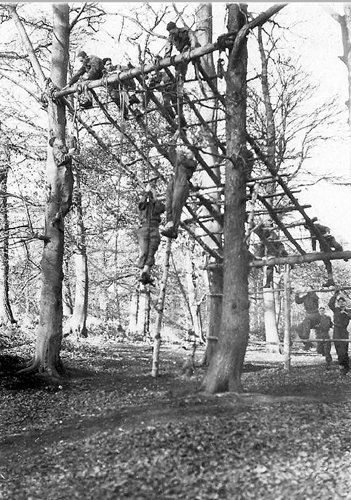
On 18 July 1947 we were asked to assemble in the barrack room where, to our surprise, we were formally discharged from the Army. However, before we could escape and disappear from Dalkeith, at the next table we had to enlist in the Regular Army on a ‘Normal 5/7 Regular Army engagement’, that is five years with the colours and seven in the reserve. We felt caught in that we just had to pass at Sandhurst otherwise, we imagined, it meant a life we did not want. For me, officially enlisted as a Signalman in the Royal Corps of Signals for 5 and 7, it would have been life as a radio mechanic or even an OWL!
Sandhurst
At the beginning of September 1947 I arrived at Sandhurst in intake 2. Intake 1 had re-started Sandhurst after the war in January and intake 1A joined in April. Intake 2 was the largest intake, consisting of about 340 cadets out of whom 326 were later commissioned, the rest having failed for some reason or other of not making the course. The Academy consisted of three colleges, Old, New and Victory, with four cadet companies in each. I was put into Rhine Company of Victory College. Due to the large intake, two cadets had to share a room. I was with someone called Chris Watson. The first morning, after breakfast we were told the day’s programme. First a Thomas Cook’s tour of the Academy; fine we thought, a gentle walk around having all the buildings explained. Disillusionment! We were formed up in threes and it was round all the buildings at the double: halt, this is the library, double march, halt, this is the gym, double march, halt, this is the church, and so it went on. Most activities were carried out with little time in between. For example, after our PT sessions in the gymnasium finished, it was strip off, then the order ‘In through the IN doors, out through the OUT doors, TOWELS’, a race through the showers, dry, into uniform, and on parade, all in 15 minutes.
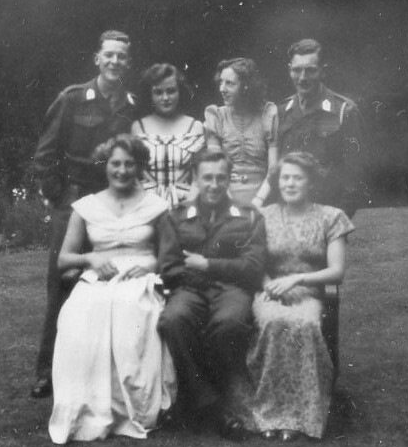
A servant, an old retired soldier, looked after our room, made the bed etc and polished our leather belts and boots. For his services we paid, what was then, the princely sum of 2/6 (12½p) a week. However, in no uncertain terms, the CSM made us aware that if we turned up on parade in ‘disorder’ we were to blame and not the servant.
As Sandhurst had only been going for six months, the training syllabus was very embryonic. The field tactical exercises, camps, visits and adventure training of later years had not yet been incorporated. Our routine consisted mainly of military training in the mornings; drill, PT, tackling obstacle courses, weapon training, driver training and MT maintenance, map reading, lessons on tactics, military law, military history and organisation of the Army.
The afternoons were devoted to sport; I played football managing to scrape into the Sandhurst second X1, boxed for the Company (until I came to a bloody end in one inter-company fight) and did a fair amount of cross-country running and athletics (long jump). In the evenings, for our educational lessons, we were permitted to wear half-dress, sports jackets over our khaki shirts. Lessons consisted of English, maths, science and languages (I took French and German but quite a few learnt Russian which was encouraged). In maths and science we were streamed according to ability. On the strength of my inter-BSc I was placed in the top stream. This turned out to be an advantage, which unknown at the time, gave bonus points towards the final order of merit. After dinner, which was formal and in uniform, with once a week the band playing, it was to the Company anteroom to read or to our rooms to press uniforms or swot for coming exams.
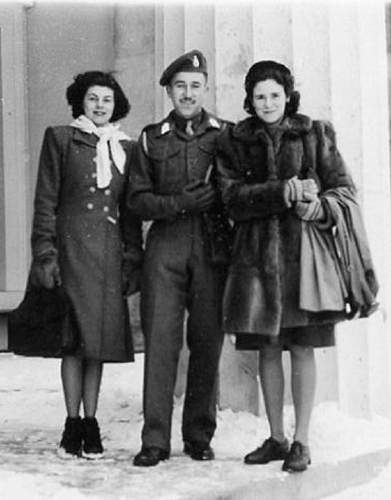
The 18 months at Sandhurst were divided into three terms – Junior, Intermediate and Senior. After about six weeks we were allowed out, provided we had passed off the square! Going out normally meant going into Camberley when we were allowed to wear civilian clothes. But we were checked at the gate that we were properly dressed with trilby hats. We went for shopping, to visit the cinema or just to walk around the town. In the second term, three of us discovered Holloway College, a higher education college for girls near Ascot. They had dances and parties but by today’s standards it was all very tame and innocent, well fairly.
What I cannot remember is how we got there, it was some distance away and no one in those days had a car. Perhaps we shared a taxi. Weekends, if not playing sports or going out, were spent on hobbies. I seemed to spend a fair amount of time in the darkroom. I held an appointment in the photographic club, entered a few competitions and was lucky enough to win some prizes. Occasionally some of us would go on organised weekend caving trips to Somerset. On other weekends we went rock climbing, once to the sandstone rocks at Tunbridge Wells where, having spent nearly 40 minutes sweating up the near-vertical faces, one was greeted by mothers pushing prams along a path at the top. After all the effort we felt cheated.
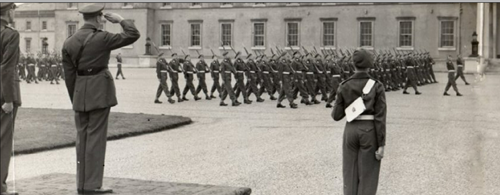
In the summer of 1948 intake 1 passed out. A very big formal parade, the first after the war, the salute was taken by King George VI. It necessitated a large number of rehearsals led by the Academy band and under the control of RSM Brand, the pre-war Academy RSM kept on to start Sandhurst up in 1947. A splendid figure in his pre-war service dress, with puttees and a stentorian voice, he was feared more by our Guardsmen instructors than the cadets who adored him. Stories about him were legion. I didn’t have many extra roll-calls (parades), given for misdemeanours. They were normally for poor turnout or ‘being idle on parade’, not hard to acquire in the prevailing high standards. On one occasion when I was on an extra roll-call Brand decided to take the parade instead of the College RSM. Brand went down the file of cadet defaulters, inspecting them. At each cadet he asked, ‘Which regiment do you think you are going into?’ ‘9/12th Lancers, Sir!’ ‘9/12th, they’ll never take you, look at you, a horrible mess, dirty belt, dirty gorgets, boots not shining,’ and so on down the line. No cadet was fit for his chosen regiment or corps, including me.
Near the end of the line Brand stopped in front of one of the foreign cadets from the Middle East. ‘And which regiment do you think you are going into?’ The cadet looking straight ahead and quietly said, ‘Sir, I have an army of my own’. Brand, who had experienced it all before and was never at a loss for words, shot back: ‘Look at you, what a mess, you don’t deserve it, you are not fit to lead them’. A great character who was heard to shout at his young son, ‘John get off my parade ground, left right, left right, left right,’ and John ran off.
The second passing out parade was held in the autumn of 1948 when Intake 1A left and we in Intake 2 became senior cadets. Cadet officers and NCOs from my intake were now appointed and being left out I asked my troop officer why. ‘You cannot all be appointed was his curt and evasive reply’. After each passing out parade there was a ball, held in the decorated gymnasium and an adjoining marquee. Bands from London played dance music; one I can remember was Edmundo Ros. With splendid buffets and liberal champagne (about £2 a bottle), they went on until about 3 in the morning. Sensibly they were held the day after the passing out parade! My passing out parade, now called The Sovereign’s Parade on the order of George VI, was on 21 December 1948. General Sir Sidney Kirkman, the QMG, took the parade. Looking now at the photos of the event, one realises just how smart we looked, marching with fixed bayonets in perfect straight lines abreast. The Guards instructors, who were kind and tolerant, had certainly done a good job and raised us to a very high standard. At the end of the parade, to the tune of Auld Land Syne, we marched up the steps of Old College, led by the adjutant on his white horse. We were commissioned but as we started to cheer, the voice of the RSM broke out: ‘Please keep quiet, gentlemen.’
The next day was OUR ball. With three balls in six months I somehow managed to take a different girl to each, Rosemary, Pamela and Anne. At my commissioning ball, it snowed heavily, curtailing any thoughts of a romantic walk outside with Anne after a dance. About four of us formed a party for each ball and found accommodation for the girls in a guesthouse about a mile out of Camberley towards Bagshot. We ran them up and down using the overstretched Camberley taxi service. The more enterprising cadets tried a nearer home solution in their rooms but were foiled by early morning rounds from the duty cadet NCOs using the Navy ‘show a leg’ inspection. The cadets were then inevitably up in front of the Commandant in the morning.
After the ball, having already collected one’s brand new one-pip uniform from Flights, the tailor in Camberley, all that remained was to assemble for the Commandant’s final address and to hear the order of passing out. Names were read out in reverse order, starting with No 326. As the list came to 200 and then 100 I began to think I had either been missed out or hadn’t heard my name; by 50 I was sure, then at No 26, Rose I.M. A result that gained me the Signals’ Agar Memorial prize as the top cadet to be commissioned into Signals as well as a £10 cheque that I later spent on having a pair of tailor-made cavalry twill trousers.
